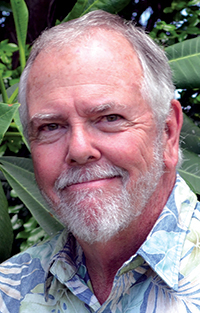A bill to prevent large commercial solar operations from setting up shop in residential neighborhoods is moving ahead in the state Legislature. ADVERTISING A bill to prevent large commercial solar operations from setting up shop in residential neighborhoods is moving
A bill to prevent large commercial solar operations from setting up shop in residential neighborhoods is moving ahead in the state Legislature.
The measure by Naalehu Rep. Richard Creagan advanced to the House Committee on Agriculture with amendments this week. Some testimony focused on the downsides of restricting solar energy development in a time when green power sources are needed more than ever. But other testimony highlighted the need to protect residential areas from commercial solar projects that could damage ambiance and property values.
House Bill 2636 would put a 25-kilowatt cap on solar generation projects located on land zoned agricultural but also serving as a residential area. Creagan introduced the bill in response to outcry from residents of Hawaiian Ocean View Ranchos, who oppose a plan by SPI Solar to place 30,000 solar panels on 26 lots in and throughout that subdivision.
The solar farm is allowed outright on agricultural land under state law designed to foster alternative energy. However, that agricultural designation includes several large subdivisions in Ka‘u and Puna, potentially placing homes and vast expanses of panels at odds with each other.
Under modifications to the bill, its provisions would apply only to the Big Island and larger solar projects could still be allowed, but only with a special permit from the county.
“There would be more of a process,” Creagan said. “It would put up roadblocks to anyone trying to come in and ram something through or be sneaky.”
But Chris Yuen, former planning director for Hawaii County and current member of the state Board of Land and Natural Resources, said in written testimony that the bill is a step backward in Hawaii’s quest for renewable energy.
“I can understand why a neighbor of a project like this might rather see a vacant lot next door rather than a solar array protected by a fence. It is not visually appealing,” Yuen wrote. “But it is not significantly less attractive than many other uses that can be made of that same lot in the ag district. For example, the lot could be covered in shade cloth structures. And I don’t see why the government, in balancing the various interests involved, would change the laws allowing a solar development like this, which would, on each lot, generate enough electricity for 50 to 100 homes.”
The bill comes too late to stop what is happening in Ranchos, as residents worry about impacts to their views, roads and property values from the commercial operation.
“SPI’s solar project is exploiting loopholes in the law by splitting a 52-acre project into 26 parts, locating each part on 26 residential lots scattered throughout the neighborhood,” wrote Sandra Shelton, secretary of the Hawaiian Ranchos Community Association, in testimony. “It is unsafe, unsightly, insecure, economically disastrous, dangerous, harmful and will cause extreme hardship to over 100 families living in the area.”
Ranchos resident Ann Bosted said the issue isn’t one of “not in my backyard.”
“The bill is of vital importance to the thousands of Hawaiians living in subdivisions that were developed back in the 1960s and ’70s and are now called nonconforming subdivisions,” Bosted said. “Some of them are huge and are home to thousands of people. Unfortunately, they are all still zoned agriculture. So, when the lawmakers in Honolulu decide that things like solar farms are OK on ag land, they are thinking of true farming land, some of which is not productive. They don’t think of the nonconforming subdivisions.”
The bill simply separates what is allowed on true agricultural land from what is allowed in housing neighborhoods zoned agricultural, Bosted said.
“I’m sure none of the politicians would like to have a solar farm built next door to them,” she said.
SPI Solar area operations manager Mick Turco asked for West Hawaii Today’s questions in an email but did not respond. Previous attempts to get comment from the company also were unsuccessful.
Email Bret Yager at byager@westhawaiitoday.com.



